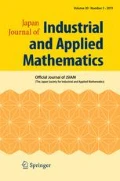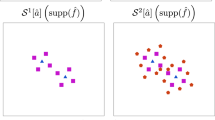Abstract
A method is proposed to compute an eigenfunction and the associated eigenvalue of the Schrödinger operatorH=−Δ+V(x), the eigenvalue being required to be closest to a given numberE. The idea is to use a time-dependent Schrödinger equation with the inhomogeneous term exp(−irE)h to excite the target mode. A device is introduced to avoid exciting remote resonant eigenvalues. Some analysis of the schemes is given and it is shown that the use of extrapolations is effective. Some numerical examples are presented. They indicate that the proposed method produces rather accurate results.
Similar content being viewed by others
References
M.D. Feit, J.A. Fleck, Jr., and A. Steiger, Solutions of the Schrödinger equation by a spectral method. J. Comput. Phys.,47 (1982), 412–433.
M.D. Feit and J.A. Fleck, Jr., Wave packet dynamics and chaos in the Hénon-Heiles system. J. Chem. Phys.,80 (1984), 2578–2584.
D.R. Grempel, R.E. Prange, and S. Fishman, Quantum dynamics of a nonintegrable system. Phys. Rev. A,29 (1984), 1639–1647.
R. Grimm and R.G. Storer, A new method for the numerical solution of the Schrödinger equation. J. Comput. Phys.,4 (1969), 230–249.
R. Grimm and R.G. Storer, Improvements on a new method for the numerical solution of the Schrödinger equation. ibid,,9 (1972), 538–546.
D.C. Joyce, Survey of extrapolation process in numerical analysis. SIAM Rev.,13 (1971), 435–490.
T. Kato, Perturbation Theory for Linear Operators. 2nd ed., 1976, Springer.
F. Odeh and J.B. Keller, Partial differential equations with periodic coefficients and Bloch waves in crystals. J. Math. Phys.,5 (1964), 1499–1504.
M. Samuelides, R. Fleckinger, L. Touzillier, and J. Bellisard, Instabilities of the quantum rotator and transition in the quasi-energy spectrum. Europhys. Lett.,1 (1986), 203–208.
J. Stoer and R. Burlrisch, Introduction to Numerical Analysis. Springer, 1980.
Appendix of the preprint of the present paper. To be published separately.
Author information
Authors and Affiliations
About this article
Cite this article
Kuroda, S.T., Suzuki, T. A time-dependent method for computing eigenfunctions and eigenvalues of Schrödinger operators. Japan J. Appl. Math. 7, 231–253 (1990). https://doi.org/10.1007/BF03167843
Received:
Issue Date:
DOI: https://doi.org/10.1007/BF03167843



